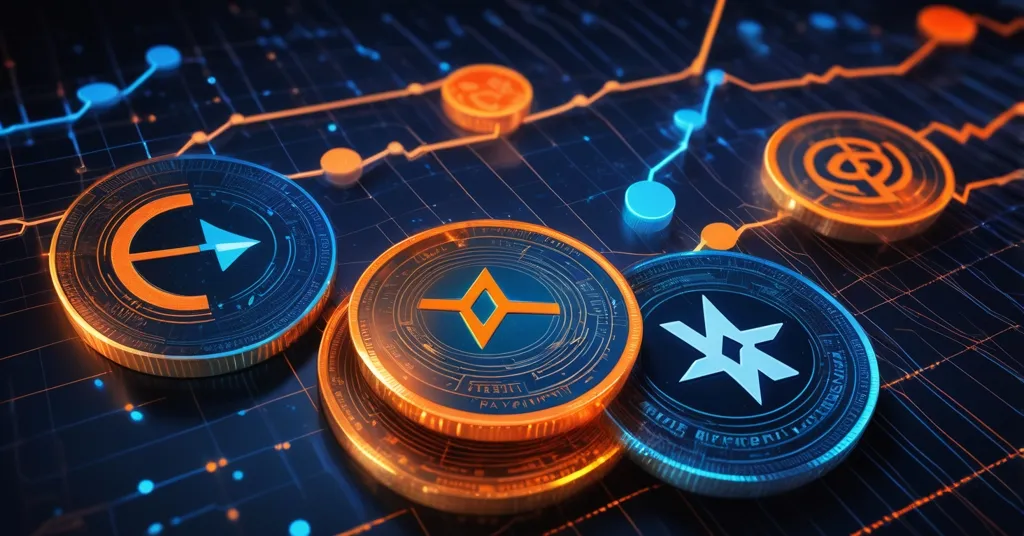XRP and Mutuum Finance: Will They Hit $9 by 2025 or Is It Just Hype?

Speculative Hype or Hidden Gems? XRP and Mutuum Finance Pegged to Hit $9 by 2025
Two tokens under $3—Ripple (XRP) and Mutuum Finance (MUTM)—are making waves with bold claims of soaring to $9 by the end of 2025. But are these predictions grounded in reality, or just another round of crypto moonshot mania? Let’s slice through the buzz and unpack the fundamentals, risks, and raw potential behind these two very different players in the blockchain space.
- XRP at $2.18: Fueled by regulatory progress and institutional traction, yet battling resistance at $2.50.
- Mutuum Finance Presale: A DeFi upstart at $0.03, raising $11.1 million, touting a 100% ROI at launch.
- $9 by 2025: Ambitious price targets for both—realistic prospects or pure speculation?
XRP: Regulatory Wins and Global Utility in Focus
Ripple’s XRP remains a heavyweight in the crypto arena, currently priced around $2.18 after a strong rally past $2 earlier in 2025. This isn’t just speculative froth—there’s substance driving the momentum. A long-standing legal battle with the U.S. Securities and Exchange Commission (SEC) has seen pivotal progress. Back in 2023, a court ruled that XRP sales on public exchanges don’t classify as securities, though institutional sales did violate regulations. Fast forward to March 2025, and Ripple’s CEO hailed the SEC dropping its appeal as a “resounding victory,” though a June 2025 decision by Judge Analisa Torres rejected a fine reduction from $125 million to $50 million, keeping penalties and injunctions intact. This legal tightrope means XRP’s path forward is promising but not without lingering uncertainty.
Beyond the courtroom, XRP’s utility is scaling fast. The XRP Ledger (XRPL) is gearing up for 2025 with major upgrades, including Ethereum Virtual Machine (EVM) sidechains that allow smart contracts to run on the network, expanding beyond basic transactions. There’s also undercollateralized lending protocols for DeFi innovation and tokenization of real-world assets, turning things like property or art into digital tokens. RippleNet, the payment network powered by XRP, operates in over 90 countries, processing $70 billion in annual transaction volume with a focus on high-speed, low-cost cross-border payments. Add partnerships in Dubai, UAE (with Zand Bank and Mamo), and Brazil (Mercado Bitcoin), plus the launch of RLUSD—a USD-backed stablecoin—and you’ve got a blockchain positioning itself as a bank-friendly disruptor. Market signals are flashing bullish too, with rising open interest (the total value of futures contracts held, signaling growing bets on price moves) and short liquidations (forced closure of bearish positions, often pushing prices up) in derivatives markets pointing to renewed confidence. Still, a technical resistance level at $2.50 looms large—breaking through will require sustained volume and sentiment as discussed in community forums.
Historically, XRP hit a peak near $3.40 during the 2017 bull run, so a jump to $9 isn’t entirely outside the realm of possibility, but it’s a steep climb. It would demand a perfect storm of regulatory clarity, mass adoption by financial institutions, and a broader market upswing. Competition is fierce too—other payment-focused blockchains like Stellar (XLM) and even traditional systems like SWIFT, with its central bank digital currency (CBDC) pilots, are vying for the same space. XRP’s strength lies in its growing real-world use, not speculative hype, making it a contender for long-term value in a decentralized financial future, especially with ongoing regulatory developments.
Mutuum Finance: DeFi Innovation or Presale Pitfall?
Shifting to Mutuum Finance (MUTM), we’re diving into riskier, less charted waters. This DeFi project is in Phase 5 of its presale, priced at a mere $0.03, and has already raised $11.1 million from over 12,400 investors. The hook? A promised 100% ROI at launch with a token price of $0.06. MUTM positions itself as a game-changer in decentralized lending, offering a dual model: Peer-to-Contract (P2C) and Peer-to-Peer (P2P). P2C lets users pool assets like stablecoins or Ethereum into smart contracts for lending, earning dynamic interest rates based on market conditions—sort of like a decentralized savings account. P2P, meanwhile, allows direct user-to-user agreements with custom terms, ideal for niche or volatile assets like meme coins. MUTM also plans a fully collateralized USD-pegged stablecoin on Ethereum, backed by real assets to minimize price swings, and touts a Layer-2 framework for low fees and scalability. Security-wise, it’s completed a CertiK audit with a Token Scan score of 95.00 and launched a $50,000 USDT bug bounty program across four severity tiers to catch vulnerabilities before they bite, as highlighted in a recent presale analysis.
Sounds impressive, right? Hold your horses. Presale projects are the Wild West of crypto—full of glittering promises but littered with scams and failures. That 100% ROI at launch is a marketing gimmick, not a binding guarantee. Post-launch performance hinges on actual adoption, utility, and market conditions, not presale hype. A $9 price by 2025 implies a 300x surge from its current value—an astronomical leap with no grounding in fundamentals or track record. Even DeFi giants like Aave or Uniswap needed years of proven utility to build significant valuations. MUTM’s CertiK audit and bug bounty are positive steps, but they don’t assure success or liquidity once the token hits exchanges. The DeFi graveyard is stacked with projects that raised millions only to rug-pull or fade into obscurity due to poor tokenomics or lack of demand, a concern raised in various online discussions. Still, if MUTM delivers on its lending model and stablecoin, it could fill a niche that Bitcoin doesn’t touch and Ethereum only partially addresses, especially for flexible, user-driven finance as explored in DeFi lending insights.
Price Predictions: Why $9 Feels Like a Long Shot
Let’s get real about these $9-by-2025 forecasts for XRP and MUTM. Bluntly put, they’re speculative at best, bordering on wishful thinking. For XRP, a 4x jump from $2.18 to $9 would require not just regulatory wins but widespread institutional adoption and a roaring bull market—possible, but hardly a sure bet given technical hurdles like the $2.50 resistance and competitive pressures. Historically, crypto price spikes often tie to broader cycles (think Bitcoin halving-driven rallies), but pinning an exact figure like $9 ignores the market’s notorious volatility, a point echoed in regulatory impact analyses. For MUTM, the prediction is even more detached from reality—a 300x gain for an untested presale project lacks any basis in adoption metrics or network growth. It’s the kind of forecast you’d expect from a carnival fortune-teller, not a serious analyst. Instead of chasing these numbers, focus on what drives value: XRP’s real-world payment solutions and whether MUTM can carve out a meaningful spot in DeFi lending without crashing and burning.
Bitcoin Maximalism vs. Altcoin Niches
As champions of Bitcoin’s dominance, we see it as the bedrock of decentralized money—unmatched in security and store-of-value credentials. But we’re not blind to the roles altcoins play. XRP’s push into cross-border payments and XRPL’s DeFi experiments tackle areas Bitcoin isn’t built for, aligning with our belief in disrupting the status quo of traditional finance. MUTM, if it proves legit, could offer a decentralized lending alternative that Bitcoin’s simplicity doesn’t accommodate and Ethereum’s high fees sometimes hinder, though its presale risks remain a concern. Yet, our Bitcoin maximalist lean reminds us to tread cautiously—altcoins must justify their existence with utility, not empty promises. The broader 2025 market context matters too: potential bull run catalysts like Bitcoin ETF inflows or favorable macroeconomics (lower interest rates, inflation hedges) could lift all boats, but they won’t magically validate every presale or price target, as seen with other token predictions. Utility, not hype, is the North Star.
Key Takeaways and Questions
- What’s fueling XRP’s current momentum?
Regulatory clarity from the SEC lawsuit, especially the 2023 ruling on public sales and the 2025 appeal drop, alongside institutional interest and RippleNet’s expansion across 90+ countries with $70 billion in transaction volume. - Can XRP realistically reach $9 by 2025?
It’s a stretch—requiring a breakout past $2.50 resistance, mass adoption by banks, and a strong bull market. While not impossible given past peaks near $3.40, it’s far from guaranteed. - What sets Mutuum Finance apart in DeFi?
Its dual P2C and P2P lending model offers flexibility for pooled and direct lending, while a planned stablecoin and CertiK audit (95.00 Token Scan score) add intrigue—though it’s unproven in a crowded space. - Is MUTM’s promised 100% ROI at launch trustworthy?
No, it’s a marketing tactic with zero assurance. Price performance after launch depends on real adoption and market dynamics, not presale claims. - How risky are DeFi presales like Mutuum Finance?
Incredibly risky—many collapse or turn out to be scams. Even with audits, there’s no certainty of success, liquidity, or team integrity. Thorough due diligence is critical. - How does XRP stack up against other payment blockchains?
XRP excels in speed and cost for cross-border transfers via RippleNet, outpacing rivals like Stellar in institutional reach, though SWIFT’s CBDC efforts pose a traditional threat. - What can investors learn from past DeFi presale failures?
Hype often masks weak fundamentals. Look for transparency in team credentials, token supply, vesting schedules, and post-launch plans before risking capital on untested projects like MUTM.
Ultimately, XRP and Mutuum Finance embody the duality of crypto—proven utility versus untamed potential. XRP offers a tangible case for disrupting global finance with real partnerships and tech upgrades, though it’s no stranger to volatility or legal headwinds. MUTM, on the other hand, is a high-stakes gamble; its DeFi lending ideas could spark innovation, or it could join the long list of presale flops. Forget the $9 fairy tales peddled by overzealous forecasters—zoom in on adoption, fundamentals, and risks. We’re all for effective accelerationism, pushing the boundaries of decentralization fast, but blind faith in moonshots stalls true progress. Question everything, and let utility, not empty hype, steer the revolution toward a freer, privacy-first financial future.



